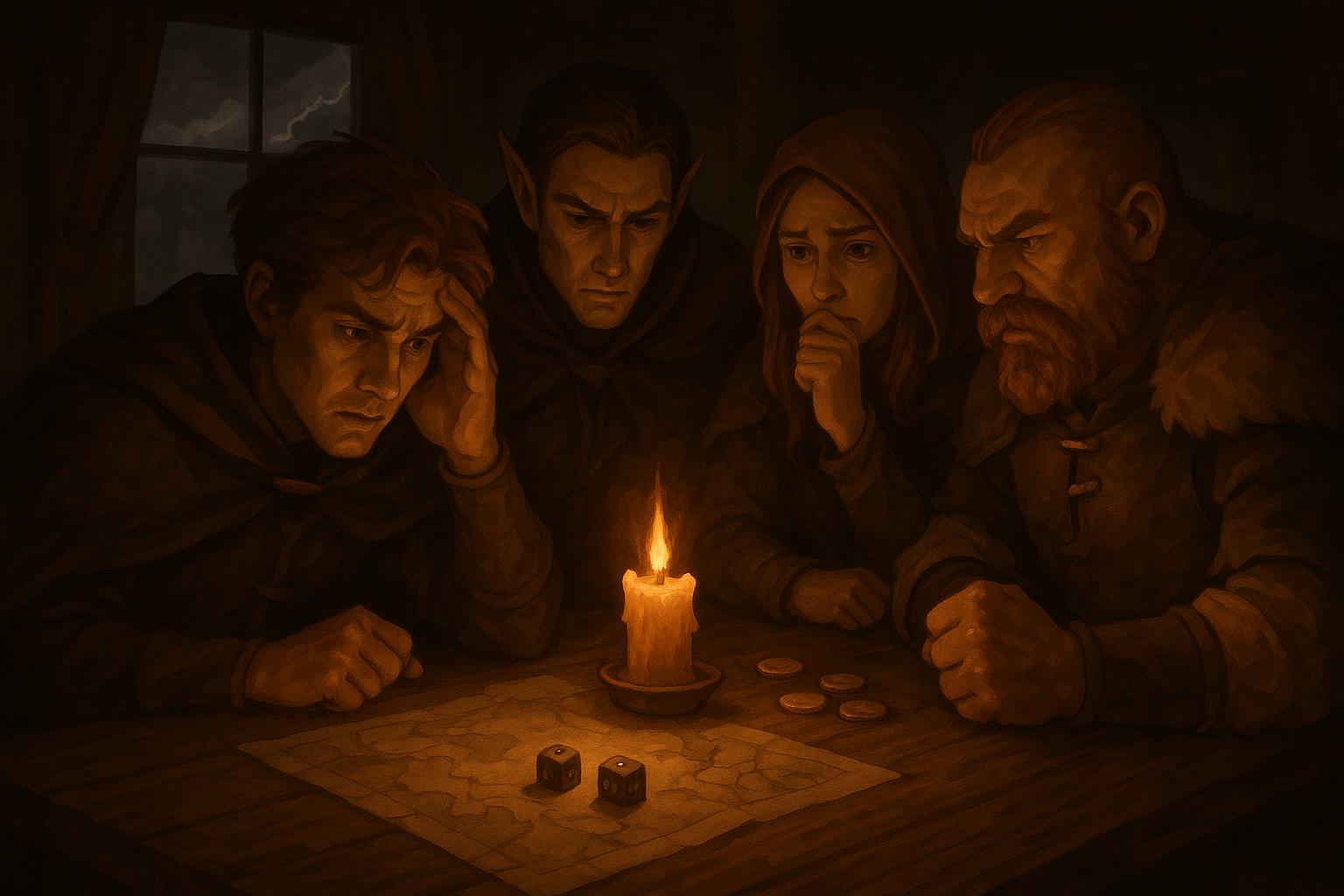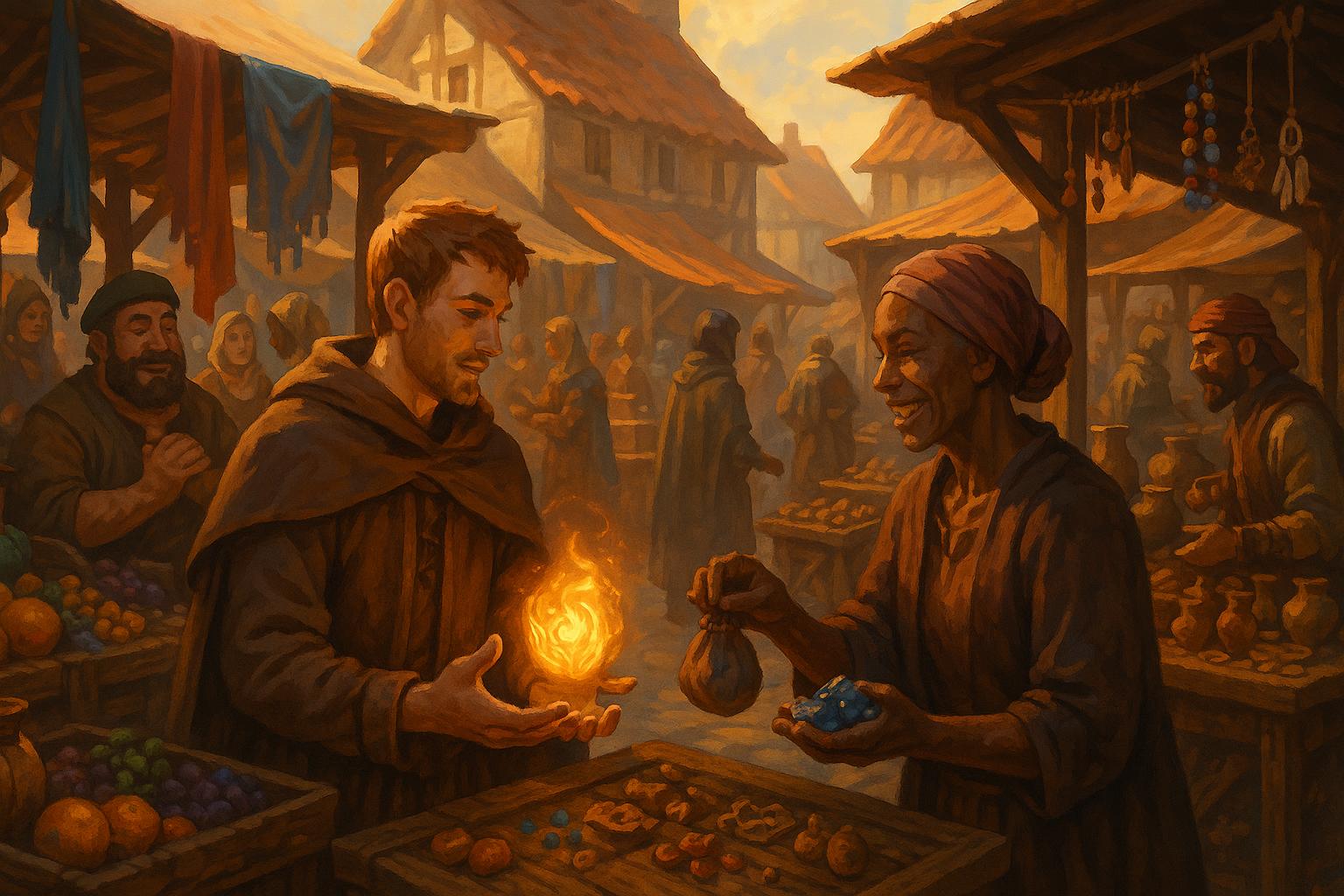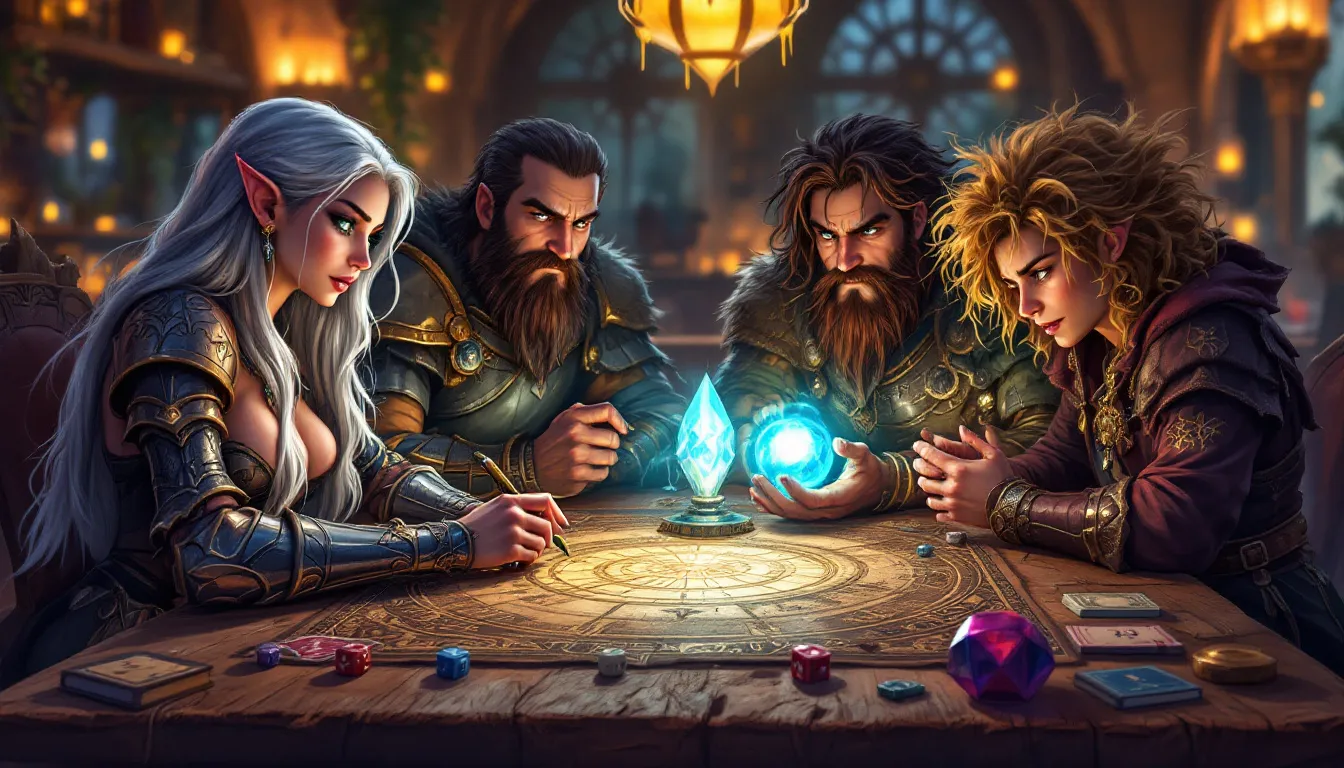NPC goals make tabletop RPGs more engaging by driving the story, creating conflicts, and making characters feel alive. Here's how to design them effectively:
- Define Clear Goals: Focus on what the NPC wants (Drive), why they want it (Motivation), and how it connects to the story (Story Alignment).
- Use the AIMS Framework:
- Agenda: What the NPC actively pursues.
- Instinct: How they naturally react.
- Moves: Specific actions they take.
- Align Goals with Story and Players: NPCs should respond to player actions while staying consistent with their personality.
- Balance Depth and Simplicity: Create layered goals (short-term, long-term) without overwhelming players or the game master.
Start by identifying an NPC's core drive, tie it to their backstory, and make sure their goals evolve with the campaign. This makes NPCs relatable, reactive, and integral to the story.
Basics of NPC Goals
Defining NPC Goals
NPC goals go beyond simply handing out quests or sharing information. They shape an NPC's personality and guide their decisions. A well-crafted goal reflects what the NPC wants and how they aim to achieve it.
"Consistency makes your NPCs feel real and believable." - Enter the Arcverse, "D&D NPCs: The Ultimate Guide" [3]
To create effective goals, it helps to break them into their key components.
Elements of NPC Goals
NPC goals can be understood through three main components:
| Element | Description | Impact on Gameplay |
|---|---|---|
| Drive | Core desires or needs | Shapes the NPC's motivations and reactions |
| Motivation | Reasons behind their actions | Dictates how NPCs work toward their objectives |
| Story Alignment | Link to the main narrative | Ensures NPCs add value to the campaign's story |
The AIMS framework (Agenda, Instinct, Moves) can simplify goal creation. For example, a merchant might have the following:
- Agenda: Expand their business.
- Instinct: Protect their family's legacy.
- Moves: Offer unique trade opportunities.
Here, the agenda represents the NPC's main goal, instinct reflects their natural tendencies, and moves are the specific actions they take to achieve their aims [1].
NPC Goals and Player Interaction
To design responsive NPCs, their goals must adjust to player decisions while staying consistent. When players interact with an NPC, their choices should influence how that character pursues their objectives. For instance, helping an NPC with a small task might lead to rewards like valuable information or additional support.
The challenge lies in balancing detail with simplicity. Goals should be rich enough to make interactions meaningful, but not so complex that they overwhelm the game master or players.
With these principles in mind, you're ready to dive into crafting NPC goals that enhance your campaign.
Related video from YouTube
Steps to Create Meaningful NPC Goals
Creating NPC goals that feel authentic and engaging can significantly enrich your campaign. Here's how to do it step by step.
1: Identify the NPC's Drive
Figure out what truly motivates your NPC at their core. This primary drive shapes their decisions and ambitions.
| Drive Type | Examples/Impact |
|---|---|
| Personal | Protect family, seek wealth (guides personal actions) |
| Professional | Expand business, advance career (affects resources and influence) |
| Social | Lead community, build reputation (shapes relationships) |
2: Determine the NPC's Motivation
Explore motivations tied to their background and circumstances. The AIMS framework is a helpful tool here, focusing on:
- Agenda: What they actively pursue
- Instincts: How they naturally react
- Moves: Specific actions they take
- Hidden Motivations: Deeper, less obvious driving forces
"By giving NPCs as much depth in their outlooks as Player Characters, DMs can add to the immersion of a campaign with a more developed supporting cast of characters." [4]
3: Align Goals with Story and Players
Once the NPC's drive and motivation are clear, connect their goals to the storyline and player interactions. This makes the NPC's journey feel tied to the players' actions, boosting engagement.
Key points to keep in mind:
- Ensure goals tie into the plot and respond to player choices.
- Create goals that actively involve players in meaningful ways.
- Stay consistent with the NPC's established character traits.
sbb-itb-b8b00a5
Tips for Effective NPC Goal Design
Keeping NPCs Consistent and Relatable
To make NPCs feel real, their goals should naturally stem from their personality and backstory. This means their actions and decisions need to align with who they are, making them feel grounded in the game world.
A strong NPC stays true to their established traits across all interactions. Their reactions should reflect their core values and behaviors. For instance, an NPC who prioritizes justice should consistently make decisions that align with that value, even when faced with tough situations or player challenges.
By tying an NPC's goals to their values, personality, and history, their actions will feel like a natural extension of the story. This consistency is key to building believable characters.
Consistency is the starting point, but NPCs also need to adapt to keep things interesting.
Designing NPCs That React to Players
NPCs should respond to player actions while staying true to their core traits. This adaptability makes the world feel interactive and alive, drawing players deeper into the story.
How NPCs react can depend on factors like the player's reputation, major events in the world, or shifting alliances. When NPCs adjust their behavior based on player choices, it creates moments that feel personal and connected to the players' decisions.
Balancing Simplicity and Depth in NPC Goals
The best NPC goals are clear yet layered. Aim to design goals that operate on different levels - short-term tasks, medium-term plans, and long-term aspirations. This approach keeps players engaged over time.
When NPC goals evolve alongside the main story, they feel more intertwined with the narrative. These layered objectives not only add depth to the characters but also help tie their motivations to the overall campaign.
Resources for TTRPG Designers
Looking to sharpen your NPC design skills and spark ideas for your campaigns? Here are some resources to help you dive deeper into creating compelling characters.
TTRPG Games Directory

The TTRPG Games Directory is a treasure trove for tabletop role-playing enthusiasts. It offers tools and insights that can directly improve your NPC creation process:
| Feature | How It Helps with NPC Design |
|---|---|
| Game Mechanics | Explore different ways NPCs can interact with players |
| Theme Exploration | Find inspiration for NPC goals across various genres |
| Character Systems | Learn techniques to add depth to NPCs |
| Story Frameworks | Connect NPC objectives seamlessly to your narrative |
Pairing these tools with the AIMS framework discussed earlier [1] can help you craft consistent and engaging characters.
Another great resource is Enter the Arcverse's detailed guides, which focus on practical NPC creation tips [3]. These guides emphasize:
- Developing strong, unique personalities
- Creating behavior patterns tied to NPC goals
- Aligning characters with the game mechanics
- Building motivations that feel authentic
Pick and choose elements that match your campaign's tone and themes to ensure everything fits together naturally.
"The key to creating memorable NPCs lies in understanding how their goals and motivations interact with the game's core mechanics and narrative structure." [3]
Conclusion: Boosting Campaigns with NPC Goals
Well-thought-out NPC goals can turn campaigns into engaging and immersive experiences. When NPCs have clear objectives, they shape the story, introduce new plot twists, and naturally encourage player involvement.
Key Points to Remember NPC goals should align with their personality, feel purposeful, and fit smoothly into the campaign's storyline. Keeping these aspects in mind helps ensure they add depth without overcomplicating the game.
Putting It Into Action Focus on the NPC's motivations and how their goals connect to the broader narrative. Striking the right balance between complexity and simplicity is key - NPCs that respond to player actions can make the game world feel more alive.
Next Steps Use these techniques to craft NPCs that leave a lasting impression. Keep an eye on their development and adjust their goals as the story unfolds to maintain a dynamic and engaging campaign.
FAQs
How to make NPCs interesting in D&D?
To create NPCs that stand out, focus on a few core elements:
Distinct Appearance and Personality: Combine unique physical features with memorable quirks or habits. For example, imagine a blacksmith who hums while working but gets annoyed if anyone doubts their craftsmanship.
Clear Goals and Motivations: NPCs with specific goals encourage player interaction and help move the storyline forward [1].
Thoughtful Design: When introducing an NPC, consider these factors:
| NPC Aspect | Purpose | Example |
|---|---|---|
| Primary Role | Advance the story | A quest giver |
| Personality | Add character depth | Odd gestures or speech |
| Motivation | Drive their actions | Expanding their shop |
| Interaction Style | Engage players | Adaptive dialogue |
By building NPCs with purpose and personality, you can create characters that players will remember long after the session ends.
What makes NPCs memorable?
Memorable NPCs combine unique traits with clear objectives. They should feel alive - reacting naturally to player actions - while being simple enough to keep the game flowing smoothly [2][3].
How do you handle NPC development over time?
As the campaign unfolds, NPCs should evolve to reflect the changing story. Track their goals and interactions with players, and think about how events or decisions might alter their motivations. This keeps the NPCs dynamic and engaging while staying true to their original personalities [3].


